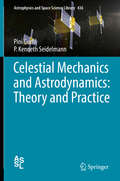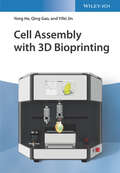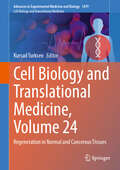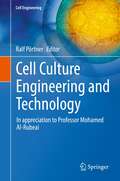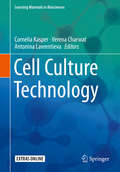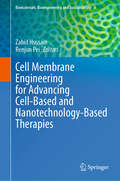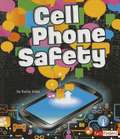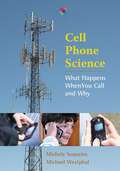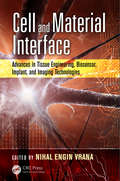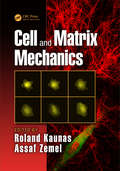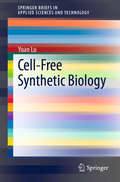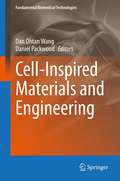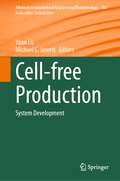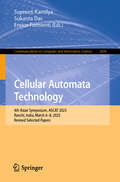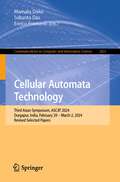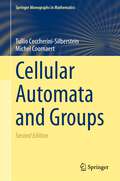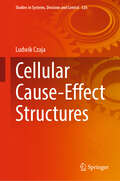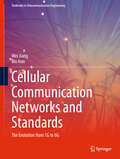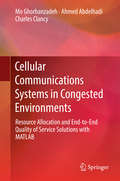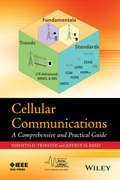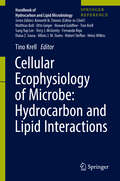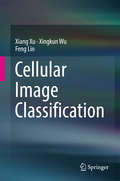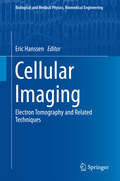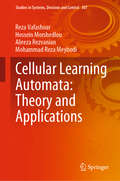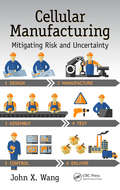- Table View
- List View
Celestial Mechanics and Astrodynamics: Theory and Practice (Astrophysics and Space Science Library #436)
by Pini Gurfil P. Kenneth SeidelmannThis volume is designed as an introductory text and reference book for graduate students, researchers and practitioners in the fields of astronomy, astrodynamics, satellite systems, space sciences and astrophysics. The purpose of the book is to emphasize the similarities between celestial mechanics and astrodynamics, and to present recent advances in these two fields so that the reader can understand the inter-relations and mutual influences. The juxtaposition of celestial mechanics and astrodynamics is a unique approach that is expected to be a refreshing attempt to discuss both the mechanics of space flight and the dynamics of celestial objects. "Celestial Mechanics and Astrodynamics: Theory and Practice" also presents the main challenges and future prospects for the two fields in an elaborate, comprehensive and rigorous manner. The book presents homogenous and fluent discussions of the key problems, rendering a portrayal of recent advances in the field together with some basic concepts and essential infrastructure in orbital mechanics. The text contains introductory material followed by a gradual development of ideas interweaved to yield a coherent presentation of advanced topics.
Cell Assembly with 3D Bioprinting
by Qing Gao Yong He Yifei JinProvides an up-to-date outline of cell assembly methods and applications of 3D bioprinting Cell Assembly with 3D Bioprinting provides an accesible overview of the layer-by-layer manufacturing of living structures using biomaterials. Focusing on technical implemention in medical and bioengineering applications, this practical guide summarize each key aspect of the 3D bioprinting process. Contributions from a team of leading researchers describe bioink preparation, printing method selection, experimental protocols, integration with specific applications, and more. Detailed, highly illustrated chapters cover different bioprinting approaches and their applications, including coaxial bioprinting, digital light projection, direct ink writing, liquid support bath-assisted 3D printing, and microgel-, microfiber-, and microfluidics-based biofabrication. The book includes practical examples of 3D bioprinting, a protocol for typical 3D bioprinting, and relevant experimental data drawn from recent research.* Highlights the interdisciplinary nature of 3D bioprinting and its applications in biology, medicine, and pharmaceutical science * Summarizes a variety of commonly used 3D bioprinting methods * Describes the design and preparation of various types of bioinks * Discusses applications of 3D bioprinting such as organ development, toxicological research, clinical transplantation, and tissue repair Covering a wide range of topics, Cell Assembly with 3D Bioprinting is essential reading for advanced students, academic researchers, and industry professionals in fields including biomedicine, tissue engineering, bioengineering, drug development, pharmacology, bioglogical screening, and mechanical engineering.
Cell Biology and Translational Medicine, Volume 24: Regeneration in Normal and Cancerous Tissues (Advances in Experimental Medicine and Biology #1479)
by Kursad TurksenThis volume in the Cell Biology and Translational Medicine series continues to explore the potential utility of stem cells in regenerative medicine. Topics covered include various aspects of stem cells in regeneration, both in health and cancer. These include research into microenvironments, signals, exosomes, biomaterials and their role in regeneration in general and in various types of cancer. A goal of the series continues to be to highlight timely, often emerging topics and novel approaches that can accelerate the utility of stem cells in regenerative medicine.
Cell Culture Engineering and Technology: In appreciation to Professor Mohamed Al-Rubeai (Cell Engineering #10)
by Ralf PörtnerThis contributed volume is dedicated towards the progress achieved within the last years in all areas of Cell Culture Engineering and Technology. It comprises contributions of active researchers in the field of cell culture development for the production of recombinant proteins, cell line development, cell therapy and gene therapy, with consideration of media development, process scale-up, reactor design, monitoring and control and model-assisted strategies for process design. The knowledge and expertise of the authors cover disciplines like cell biology, engineering, biotechnology and biomedical sciences. This book is conceived for graduate students, postdoctoral fellows and researchers interested in the latest developments in Cell Engineering.
Cell Culture Technology (Learning Materials in Biosciences #4)
by Cornelia Kasper Verena Charwat Antonina LavrentievaThis textbook provides an overview on current cell culture techniques, conditions, and applications specifically focusing on human cell culture. This book is based on lectures, seminars and practical courses in stem cells, tissue engineering, regenerative medicine and 3D cell culture held at the University of Natural Resources and Life Sciences Vienna BOKU and the Gottfried Wilhelm Leibniz University Hannover, complemented by contributions from international experts, and therefore delivers in a compact and clear way important theoretical, as well as practical knowledge to advanced graduate students on cell culture techniques and the current status of research. The book is written for Master students and PhD candidates in biotechnology, tissue engineering and biomedicine working with mammalian, and specifically human cells. It will be of interest to doctoral colleges, Master- and PhD programs teaching courses in this area of research.
Cell Membrane Engineering for Advancing Cell-Based and Nanotechnology-Based Therapies (Biomaterials, Bioengineering and Sustainability #6)
by Zahid Hussain Renjun PeiThe battle against complex diseases and tissue defects drives innovation in treatment and medical research. The cell membrane plays a fundamental role in biological processes and serves as a promising platform for diagnostic and therapeutic advancements due to its diverse receptors and ligands. Recent advances in bioengineering, synthetic biology, and biomimetic nanotechnology have enabled the development of engineered cell membrane-based platforms, including surface-engineered cells, extracellular vesicles, bacterial membrane vesicles, membrane-coated nanoparticles, and hybrid nanomaterials, offering improved therapeutic and diagnostic potential over their natural counterparts. This book provides a comprehensive exploration of essential cell surfaceome components, detailing state-of-the-art surface engineering strategies and advancements in engineered cells and membrane-based therapeutic nanoplatforms. It examines the transformative applications of these platforms in immune engineering, gastrointestinal disease management, cancer therapy, tissue engineering, circulating tumor cell capture, theranostics, and the treatment of neurodegenerative, inflammatory, and infectious diseases. Significant topics, many at the forefront of scientific research, are examined in depth, allowing academics, clinicians, and biomedical researchers to understand the latest advancements in cell membrane engineering and address unmet clinical needs. Furthermore, this interdisciplinary book is highly relevant to modern healthcare and provides instructional content for graduate students in <span lang="ZH-CN" style="font-size: 12.0pt; line-height: 150%; font-family: 'Arial',sans-serif; mso-fareast-font-family: Aptos; mso-fareast-theme-font: minor-latin; mso-ansi-language: ZH-CN; mso-fareast-lan
Cell Phone Safety
by Frank W. Baker Kathy AllenIf you get a text from a stranger, do you know what to do? Don't worry if you don't. This book is here to help! Learn tech-savvy ways to keep your cell phone a safe zone without taking away all the fun!
Cell Phone Science: What Happens When You Call and Why (Barbara Guth Worlds of Wonder Science Series for Young Readers)
by Michael Westphal Michele SequeiraTheir buzzes, beeps, bells, and tunes have disrupted countless classes, movies, and meals; public auditoriums now have signs posted prominently asking people to turn their cell phones off; cities such as Santa Fe have banned their use in automobiles. But these little connection gadgets have become ubiquitous because they are so useful-many would blanch at the thought of losing their cell phone. Cell phones are useful because of the science, technology, and design that are blended to make them function. In this work, authors Michele Sequeira and Michael Westphal help young people explore this now-commonplace, socially important gadget that connects today's youth with their friends. The underlying science and technologies, and some of the history that has influenced the development of cell phones, are discussed. Emphasis is given to building science and technology concepts through simple analogies with commonplace items and ideas.
Cell and Material Interface: Advances in Tissue Engineering, Biosensor, Implant, and Imaging Technologies (Devices, Circuits, and Systems)
by Nihal Engin VranaA significant portion of biomedical applications necessitates the establishment of an interface between the cells of the patient and the components of the device. In many cases, such as in implants and engineered tissues, the interaction of the cells with the biomaterial is one of the main determinants of the success of the system. Cell and Material Interface: Advances in Tissue Engineering, Biosensor, Implant, and Imaging Technologies explores this interaction and its control at length scales ranging from the nano to the macro.Featuring contributions from leading molecular biologists, chemists, and material scientists, this authoritative reference: Presents practical examples of cell and material interface-based applications Reflects the interdisciplinary nature of bioengineering, covering topics such as biosensing, immunology, and controlled delivery Explains the role of the cell and material interface in the context of cardiac and skin tissue engineering, nanoparticles, natural polymers, and more Cell and Material Interface: Advances in Tissue Engineering, Biosensor, Implant, and Imaging Technologies addresses concepts essential to biomaterial production methods and cell and material interactions. The book provides a solid starting point for elucidating and exploiting the different aspects of cellular interactions with materials for biomedical engineering.
Cell and Matrix Mechanics
by Roland Kaunas Assaf ZemelExplores a Range of Multiscale Biomechanics/Mechanobiology ConceptsCell and Matrix Mechanics presents cutting-edge research at the molecular, cellular, and tissue levels in the field of cell mechanics. This book involves key experts in the field, and covers crucial areas of cell and tissue mechanics, with an emphasis on the roles of mechanical forc
Cell-Free Synthetic Biology (SpringerBriefs in Applied Sciences and Technology)
by Yuan LuThis book describes advanced studies in cell-free synthetic biology, an emerging biotechnology that focuses on cell-free protein synthesis and cell-free systems for fundamental and industrial research in areas such as genetic circuit design, small-molecule synthesis, complicated-macromolecule synthesis, unnatural-macromolecule synthesis, high-throughput screening, artificial cells, and biomaterials. Cell-free synthetic biology is now an integral part of developing fields like nanotechnology, materials science, and personalized medicine. The book discusses the main research directions in the development of cell-free systems, as well as a number of applications of cell-free synthetic biology, ranging from structural biology to the human health industry. It is intended for students and researchers in life sciences, synthetic biology, bioengineering, and chemical engineering.
Cell-Inspired Materials and Engineering (Fundamental Biomedical Technologies)
by Daniel Packwood Dan Ohtan WangThis book highlights cutting-edge studies in the development of cell-inspired biomaterials and synthetic materials that manipulate cell functions and provide the next generation with contemporary tools for treating complex human diseases. It explores the convergence of synthetic materials with cell and molecular biology and surveys how functional materials, when patterned with spatial and temporal precision, can be used effectively to maintain cell proliferation and phenotype in vitro, to trigger specific cell functions, and to redirect cell-fate decisions. Human stem cells are a frequently discussed subject in this book. This is an ideal book for students, cell biologists, researchers interested in interdisciplinary research, and biomedical engineers. This book also: Highlights successfully developed technologies in cell engineering that make possible new therapeutic development for previously untreatable conditions Covers topics including bio-inspired micro patterning, DNA origami technology, synthetic NOS inspired by compartmentalized signaling in cells, and light-induced depolarization of the cell membrane Illustrates in detail the use of stem cells and synthetic scaffolds to model ethically sensitive embryonic tissues and organs
Cell-free Production: System Development (Advances in Biochemical Engineering/Biotechnology #186)
by Yuan Lu Michael C. JewettThis book reviews the development of cell-free production platforms and offers an authoritative perspective of the latest advances and methodologies in cell-free production systems. Readers will discover the biomanufacturing potential of in vitro biotransformation (ivBT) employing purified cascade multi-enzymes, the development of hydrogel-based multi-enzymatic systems for biosynthesis, and novel insights into the optimization of biocatalytic processes. Additionally, the book explores the cell-free production and regeneration of cofactors, shedding light on strategies to enhance the efficiency and sustainability of cellular processes. In this book, particular attention is given to the progress of cell-free in vitro evolution techniques for optimizing enzyme performance, and the book also presents the integration of rapid and finely-tuned expression systems for deployable sensing applications, revolutionizing the field of biosensing. The synthesis and electrophysiological analysis of multipass voltage-gated ion channels tethered in microsomal membranes are explored, providing a deep understanding of cellular function at the molecular level. Lastly, the book covers compartmentalized cell-free expression systems for building synthetic cells, showcasing the potential for constructing artificial cellular systems with unique functionalities. Given its breadth, this book appeals to academics, researchers, and professionals interested in the forefront of biotechnology, and together with the companion volume “Cell-free Macromolecular Synthesis”, both books highlight the research progresses on the basic and applied research of cell-free production systems in the last few years, being invaluable resources in the field.Chapter “Cell-free synthesis and electrophysiological analysis of multipass voltage-gated ion channels tethered in microsomal membranes” is available open access under a Creative Commons Attribution 4.0 International License via link.springer.com.
Cellular Automata Technology: 4th Asian Symposium, ASCAT 2025, Ranchi, India, March 6–8, 2025, Revised Selected Papers (Communications in Computer and Information Science #2499)
by Enrico Formenti Sukanta Das Supreeti KamilyaThis book constitutes the refereed conference proceedings of the 4th Asian Symposium on Cellular Automata Technology, ASCAT 2025, held in Ranchi, India, during March 6–8, 2025. The 16 full papers included in this book were carefully reviewed and selected from 35 submissions. This symposium aims to explore the latest insights and innovations in multiple theoretical aspects of Cellular Automata Technology and their applications across various domains.
Cellular Automata Technology: Third Asian Symposium, ASCAT 2024, Durgapur, India, February 29–March 2, 2024, Revised Selected Papers (Communications in Computer and Information Science #2021)
by Enrico Formenti Sukanta Das Mamata DaluiThis book constitutes the refereed conference proceedings of the Third Asian Symposium on Cellular Automata Technology, ASCAT 2024, held in Durgapur, India, during February 29 - March 2, 2024.The 15 full papers presented in this book were carefully reviewed and selected from 33 submissions. The symposium aims to explore the latest advancements, methodologies, and interdisciplinary connections that showcase the versatility and potential impact of cellular automata in contemporary research.
Cellular Automata and Groups (Springer Monographs in Mathematics)
by Tullio Ceccherini-Silberstein Michel CoornaertThis unique book provides a self-contained exposition of the theory of cellular automata on groups and explores its deep connections with recent developments in geometric and combinatorial group theory, amenability, symbolic dynamics, the algebraic theory of group rings, and other branches of mathematics and theoretical computer science. The topics treated include the Garden of Eden theorem for amenable groups, the Gromov–Weiss surjunctivity theorem, and the solution of the Kaplansky conjecture on the stable finiteness of group rings for sofic groups. Entirely self-contained and now in its second edition, the volume includes 10 appendices and more than 600 exercises, the solutions of which are presented in the companion book Exercises in Cellular Automata and Groups (2023) by the same authors. It will appeal to a large audience, including specialists and newcomers to the field.
Cellular Cause-Effect Structures (Studies in Systems, Decision and Control #526)
by Ludwik CzajaThis book presents the adaptation of cause-effect structures to the formal description of phenomena such as the behaviour of living objects, the mutual communication of living cells, but also such as the growth of crystals and other natural processes. The system of cause-effect structures has been designed for the description and analysis of objects with dispersed components, acting concurrently and synchronizing and communicating one another. This adaptation consists in customizing generic semantics of cause-effect structures to semantics specific to the behaviour of natural objects. That is creating evolution rules for the formal models of these objects. However, the structural, algebraic properties of cause-effect structures are retained. The activity of cellular cause-effect structures is supposed to imitate the activity of cellular automata, the formal system intended for the above-mentioned aims. But operations on syntactic constructions, in particular their transformations and simplification, are the same as for the general cause-effect structures. These algebraic operations are also used to perform certain geometric/topological conversions of location bases for the cellular cause-effect structures, like flat surfaces into cylindrical or toroidal. This is depicted by numerous illustrations. An adaptation of cause-effect structures to other formal descriptions of some natural phenomena, such as reaction systems, is provided in book 331 of the “Lecture Notes in Networks and Systems” series, whereas the complete description of cause-effect structures, in book 45.
Cellular Communication Networks and Standards: The Evolution from 1G to 6G (Textbooks in Telecommunication Engineering)
by Wei Jiang Bin HanThis textbook provides a comprehensive review of the evolution of mobile communications and networking from the birth of cellular networks to the forthcoming sixth-generation mobile communications, which is envisioned to be commercially deployed first in 2030. New students who are coming to wireless communications/electrical engineering/computer networking/telecommunications and network engineering can benefit from this book by quickly grasping the whole history of cellular networks, understanding its trends. This tutorial styled textbook provides a comprehensive overview, but also provides details of the system design aspects of the various cellular generations up to 6G and how they build on each other. The book also gives the student an overview of different cellular generations’ motivations, core technologies, architecture, key performance indicators, killer applications, market drivers, and the general/main features of each. The authors capture the big picture and fundamental drivers of wireless communication technologies, and then motivate students to understand the importance of learning related subjects such as electromagnetics theory, antenna design, analog and digital circuits, signal processing, Internet protocols, artificial intelligence, etc. The book features homework questions and case studies throughout.
Cellular Communications Systems in Congested Environments: Resource Allocation and End-to-End Quality of Service Solutions with MATLAB
by Ahmed Abdelhadi Mo Ghorbanzadeh Charles ClancyThis book presents a mathematical treatment of the radio resource allocation of modern cellular communications systems in contested environments. It focuses on fulfilling the quality of service requirements of the living applications on the user devices, which leverage the cellular system, and with attention to elevating the users' quality of experience. The authors also address the congestion of the spectrum by allowing sharing with the band incumbents while providing with a quality-of-service-minded resource allocation in the network. The content is of particular interest to telecommunications scheduler experts in industry, communications applications academia, and graduate students whose paramount research deals with resource allocation and quality of service.
Cellular Communications: A Comprehensive and Practical Guide
by Jeffrey H. Reed Nishith TripathiEven as newer cellular technologies and standards emerge, many of the fundamental principles and the components of the cellular network remain the same. Presenting a simple yet comprehensive view of cellular communications technologies, Cellular Communications provides an end-to-end perspective of cellular operations, ranging from physical layer details to call set-up and from the radio network to the core network. This self-contained source forpractitioners and students represents a comprehensive survey of the fundamentals of cellular communications and the landscape of commercially deployed 2G and 3G technologies and provides a glimpse of emerging 4G technologies.
Cellular Ecophysiology of Microbe: Hydrocarbon and Lipid Interactions
by Tino KrellThis book assembles concisely written chapters by world-leaders in the field summarizing recent advances in understanding microbial responses to hydrocarbons. Subjects treated include mechanisms of sensing, hydrocarbon tolerance and degradation as well as an overview on hydrophobic modification of biomolecules. Other chapters are dedicated to issues related to the reduced bioavailability of hydrocarbons, which differentiates this class of compounds form many others, but which of central importance to understand the ecophysiological consequences. This book should be standard literature in any laboratory working in this area.
Cellular Image Classification
by Xiang Xu Xingkun Wu Feng LinThis book introduces new techniques for cellular image feature extraction, pattern recognition and classification. The authors use the antinuclear antibodies (ANAs) in patient serum as the subjects and the Indirect Immunofluorescence (IIF) technique as the imaging protocol to illustrate the applications of the described methods. Throughout the book, the authors provide evaluations for the proposed methods on two publicly available human epithelial (HEp-2) cell datasets: ICPR2012 dataset from the ICPR''12 HEp-2 cell classification contest and ICIP2013 training dataset from the ICIP''13 Competition on cells classification by fluorescent image analysis. First, the reading of imaging results is significantly influenced by one''s qualification and reading systems, causing high intra- and inter-laboratory variance. The authors present a low-order LP21 fiber mode for optical single cell manipulation and imaging staining patterns of HEp-2 cells. A focused four-lobed mode distribution is stable and effective in optical tweezer applications, including selective cell pick-up, pairing, grouping or separation, as well as rotation of cell dimers and clusters. Both translational dragging force and rotational torque in the experiments are in good accordance with the theoretical model. With a simple all-fiber configuration, and low peak irradiation to targeted cells, instrumentation of this optical chuck technology will provide a powerful tool in the ANA-IIF laboratories. Chapters focus on the optical, mechanical and computing systems for the clinical trials. Computer programs for GUI and control of the optical tweezers are also discussed. to more discriminative local distance vector by searching for local neighbors of the local feature in the class-specific manifolds. Encoding and pooling the local distance vectors leads to salient image representation. Combined with the traditional coding methods, this method achieves higher classification accuracy. Then, a rotation invariant textural feature of Pairwise Local Ternary Patterns with Spatial Rotation Invariant (PLTP-SRI) is examined. It is invariant to image rotations, meanwhile it is robust to noise and weak illumination. By adding spatial pyramid structure, this method captures spatial layout information. While the proposed PLTP-SRI feature extracts local feature, the BoW framework builds a global image representation. It is reasonable to combine them together to achieve impressive classification performance, as the combined feature takes the advantages of the two kinds of features in different aspects. Finally, the authors design a Co-occurrence Differential Texton (CoDT) feature to represent the local image patches of HEp-2 cells. The CoDT feature reduces the information loss by ignoring the quantization while it utilizes the spatial relations among the differential micro-texton feature. Thus it can increase the discriminative power. A generative model adaptively characterizes the CoDT feature space of the training data. Furthermore, exploiting a discriminant representation allows for HEp-2 cell images based on the adaptive partitioned feature space. Therefore, the resulting representation is adapted to the classification task. By cooperating with linear Support Vector Machine (SVM) classifier, this framework can exploit the advantages of both generative and discriminative approaches for cellular image classification. The book is written for those researchers who would like to develop their own programs, and the working MatLab codes are included for all the important algorithms presented. It can also be used as a reference book for graduate students and senior undergraduates in the area of biomedical imaging, image feature extraction, pattern recognition and classification. Academics, researchers, and professional will find this to be an exceptional resource.
Cellular Imaging: Electron Tomography and Related Techniques (Biological and Medical Physics, Biomedical Engineering)
by Eric HanssenThis book highlights important techniques for cellular imaging and covers the basics and applications of electron tomography and related techniques. In addition, it considers practical aspects and broadens the technological focus by incorporating techniques that are only now becoming accessible (e. g. block face imaging). The first part of the book describes the electron microscopy 3D technique available to scientists around the world, allowing them to characterize organelles, cells and tissues. The major emphasis is on new technologies like scanning transmission electron microscopy (STEM) tomography, though the book also reviews some of the more proven technologies like electron tomography. In turn, the second part is dedicated to the reconstruction of data sets, signal improvement and interpretation
Cellular Learning Automata: Theory and Applications (Studies in Systems, Decision and Control #307)
by Alireza Rezvanian Mohammad Reza Meybodi Reza Vafashoar Hossein MorshedlouThis book highlights both theoretical and applied advances in cellular learning automata (CLA), a type of hybrid computational model that has been successfully employed in various areas to solve complex problems and to model, learn, or simulate complicated patterns of behavior. Owing to CLA’s parallel and learning abilities, it has proven to be quite effective in uncertain, time-varying, decentralized, and distributed environments. The book begins with a brief introduction to various CLA models, before focusing on recently developed CLA variants. In turn, the research areas related to CLA are addressed as bibliometric network analysis perspectives. The next part of the book presents CLA-based solutions to several computer science problems in e.g. static optimization, dynamic optimization, wireless networks, mesh networks, and cloud computing. Given its scope, the book is well suited for all researchers in the fields of artificial intelligence and reinforcement learning.
Cellular Manufacturing: Mitigating Risk and Uncertainty (Systems Innovation Book Series)
by John X. WangIn today's business world, competitiveness defines the industrial leading edge. Organizations and businesses of all sizes are adopting Lean manufacturing practices to increase efficiency and address worries about their bottom lines. In a detailed review of this staple of Lean manufacturing, Cellular Manufacturing: Mitigating Risk and Uncertainty ou
